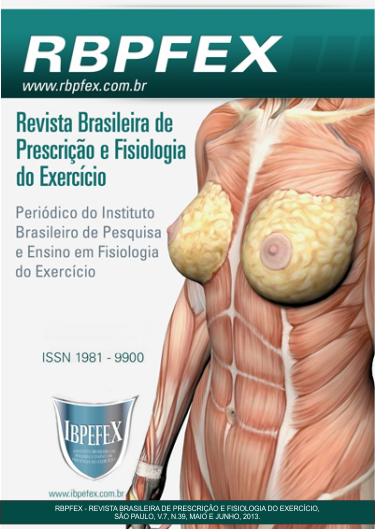Sports performance in the wheelchair rugby athletes: a systematic review
Abstract
Objective: To determine through of a systematic review the key components related to physiological and physical performance in athletes wheelchair rugby. Method: For the search, we used the descriptors "Wheelchair" and "Rugby" isolated and / or combined. We analyzed the studies originally published in English between January 2004 to December 2012, in databases PubMed, Scopus and Web of Science. Results: Initially, 105 studies were identified. After excluding duplicates, reading the titles and abstracts, 17 articles were included and analyzed. The main component of the physical performance of athletes wheelchair rugby were related to be aerobic power (VO2 max.) And indicators of volume and intensity were:rating of perceived exertion, distance covered, total, heart rate and lactate concentration. Conclusion: Athletes and coaches rugby in wheelchairs must included training involving aerobic capacity, change of the direction, speed and muscle strengthening.
References
-Barfield, J. P.; e colaboradores. Exercise intensity during wheelchair rugby training. J Sports Sci. Vol. 28. Num. 4. p. 389-398. 2010.
-Campana, M. B.; e colaboradores. O Rugby em Cadeira de Rodas: aspectos técnicos e táticos e diretrizes para seu desenvolvimento Motriz. Revista de Educação Física. Vol. 17. Num. 4. p. 748-757. 2011.
-Denadai, B. S. Determinação do limiar anaeróbio em jogadores de futebol com paralisia cerebral e nadadores participantes da paraolimpíada de Sidney 2000. Rev Bras Med Esporte. Vol. 8. Num. 3. p. 117-122. 2002.
-DePauw, K. P.; Gavron, S. J. Disability Sport. Champaign, IL: Human Kinetics, 2005.
-Furmaniuk, L.; Cywinska-Wasilewska, G.; Kaczmarek, D. Influence of long-term wheelchair rugby training on the functional abilities in persons with tetraplegia over a two-year post-spinal cord injury. J Rehabil Med. Vol. 42. Num. 7. p. 688-690. 2010.
-Gorla, J. I.; Campana, M. B.; Campos, L. F. C. C. Rugby em Cadeira de Rodas. In Mello, M. T. e Winckler, C. Esporte Paralímpico. São Paulo. Editora Atheneu, 2012.
-Hanrahan, S. J. Athletes with Disabilities. In: Tenenbaum, G. e Eklund, R. C. Handbook of Sport Psychology. New York: MacMillan, 2007.
-Heath, G. W.; Fentem, P. H. Physical activity among persons with disabilities: A public health perspective. Exercise Sport Science Review. Vol. 25. p. 195-234. 1997.
-Leicht, C. A.; Bishop, N. C.; Goosey-Tolfrey, V. L. Mucosal immune responses during court trainingin elite tetraplegic athletes. Spinal Cord. Vol. 50, Num. 10. p. 760-765. 2012a.
-Leicht, C. A.; Bishop, N. C.; Goosey-Tolfrey, V. L. Submaximal exercise responses in tetraplegic, paraplegic and non spinal cord injured elite wheelchair athletes. Scand J Med Sci Sports. Vol. 22, Num. 6. p. 729-736. 2012b.
-Leicht, C. A.; Bishop, N. C.; Paulson, T. A.; Griggs, K. E.; Goosey-Tolfrey, V. L. Salivary immunoglobulin A and upper respiratory symptoms during 5 months of training in elite tetraplegic athletes.Int J Sports Physiol Perform. Vol. 7. Num. 3. p. 210-217. 2012.
-Mason, B. S.; Van Der Woude, L. H.; Goosey-Tolfrey, V. L. Influence of glove type on mobility performance for wheelchair rugby players. Am J Phys Med Rehabil. Vol. 88, Num. 7. p. 559-570. 2009.
-Molik, B.; e colaboradores. An examination of the international wheelchair rugby Federation classification system utilizing parameters of offensive game efficiency. Adapt Phys Activ Q. Vol. 25.Num. 4. p. 335-351. 2008.
-Moreno, M. A.; e colaboradores. Effects of wheelchair sports on respiratory muscle strength and thoracic mobility of individuals with spinal cord injury. Am J Phys Med Rehabil. Vol. 91, Num. 6. p. 470-477. 2012.
-Morgulec-Adamowicz, N.; e colaboradores. Game Efficiency of Wheelchair Rugby Athletes at the 2008 Paralympic Games with Regard to Player Classification. Human Movement. Vol. 11, Num. 1. p. 29-36. 2010.
-Morgulec-Adamowicz, N.; e colaboradores. Aerobic, anaerobic, and skill performance with regard to classification in wheelchair rugby athletes. Res Q Exerc Sport. Vol. 82, Num. 1. p. 61-69. 2011.
-Noce, F.; Simim, M. A. M.; Mello, M. T. A percepção de qualidade de vida de pessoas portadoras de deficiência física pode ser influenciada pela prática de atividade física? Revista Brasileira de Medicina do Esporte. Vol. 15. p. 174-178. 2009.
-Sarro, K. J.; e colaboradores. Tracking of wheelchair rugby players in the 2008 Demolition Derby final. J Sports Sci. Vol. 28. Num. 2. p. 1-8. 2010.
-Silva, A. C.; Andrade, M. S. Avaliação isocinética em atletas paraolímpicos. Rev Bras Med Esporte. Vol. 8. Num. 3. p. 99-101. 2002.
-Tabęcki, R.; Kosmol, A.; Mastalerz, A. Effects of Strength Training on Physical Capacities of the Disabled with Cervical Spine Injuries. Human Movement. Vol. 10, Num. 2. p. 126-129. 2009.
-Taylor, B. J.; West, C. R.; Romer, L. M. No effect of arm-crank exercise on diaphragmatic fatigue or ventilatory constraint in Paralympic athletes with cervical spinal cord injury. J Appl Physiol. Vol. 109. Num. 2. p. 358-366. 2010.
-West, C. R.; e colaboradores. Resting cardiopulmonary function in Paralympic athletes with cervical spinal cord injury. Med Sci Sports Exerc. Vol. 44. Num. 2. p. 323-329. 2012.
-West, C. R.; Romer, L. M.; Krassioukov, A. Autonomic Function and Exercise Performance in Elite Athletes with Cervical Spinal Cord Injury. Med Sci Sports Exerc. 2012.
-Winnick, J. Educação Física e Esportes Adaptados. Manole. 2004.
Authors who publish in this journal agree to the following terms:
- Authors retain the copyright and grant the journal the right of first publication, with work simultaneously licensed under the Creative Commons Attribution License BY-NC which allows the sharing of the work with acknowledgment of the authorship of the work and initial publication in this journal.
- Authors are authorized to enter into additional contracts separately for non-exclusive distribution of the version of the work published in this journal (eg, publishing in institutional repository or book chapter), with acknowledgment of authorship and initial publication in this journal.
- Authors are allowed and encouraged to post and distribute their work online (eg, in institutional repositories or on their personal page) at any point before or during the editorial process, as this can bring about productive change as well as increase impact and impact. citation of published work (See The Effect of Free Access).






